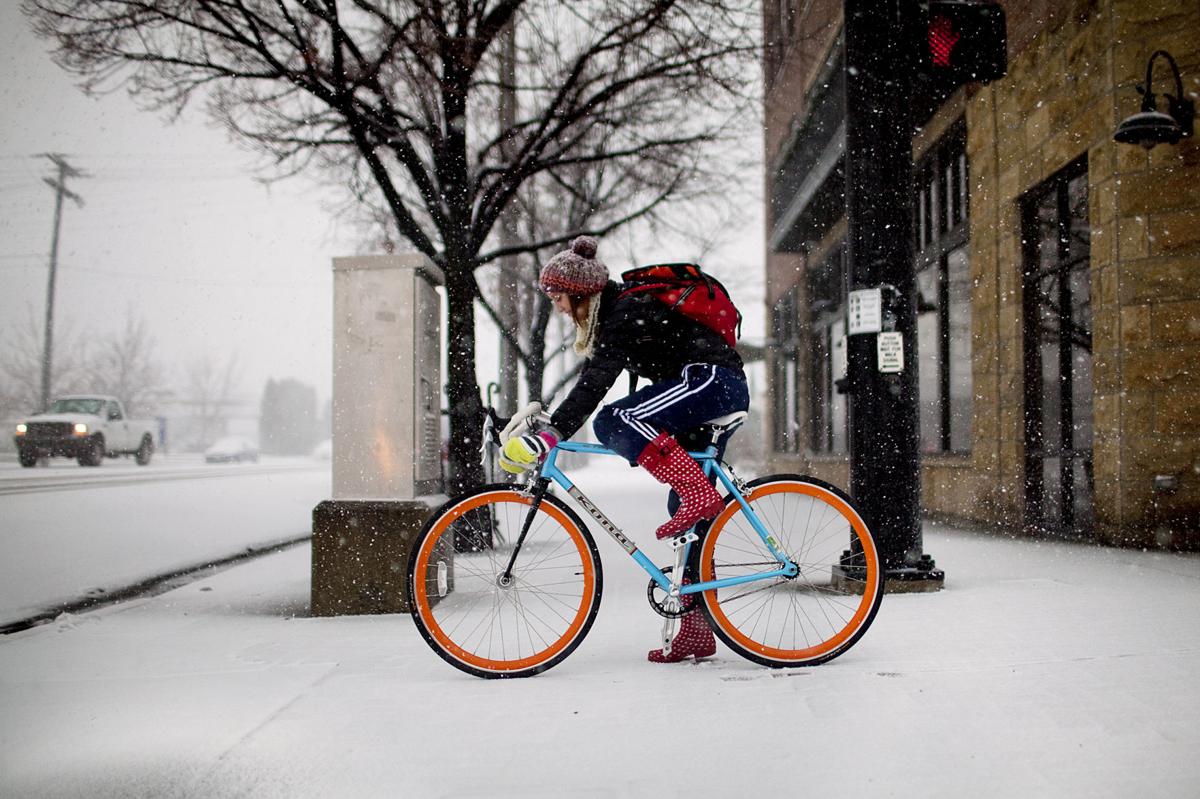To bike commute through winter, dress in layers and equip your bike with proper lights and tires. Ensure you stay visible and safe.
Winter bike commuting can seem daunting, but it’s manageable with the right preparation. Dressing in layers helps regulate body temperature and keeps you warm. Equip your bike with bright lights to enhance visibility during shorter daylight hours. Installing winter tires with better grip ensures safer rides on icy or snowy roads.
Regularly maintain your bike to prevent issues caused by cold weather. Plan your route carefully, opting for well-lit, plowed paths whenever possible. With these steps, you can enjoy a safe and efficient winter bike commute.
The Lure Of Winter Biking
Winter biking feels like an adventure. The cold air wakes you up. Snow adds a touch of magic. Fewer cars on the road make it peaceful. You get to see winter landscapes up close. Riding in the cold builds resilience. Every ride feels like a small victory.
Biking in cold weather burns more calories. Your body works harder to stay warm. This boosts your metabolism. Winter biking strengthens your immune system. Fresh air improves your mood. Regular rides keep you fit and healthy. Cold air can clear your lungs. You feel more awake and alert.
Prepping Your Bike For Winter
Winter roads can be slippery. Use tires with good grip. Wide tires offer better stability. Studded tires are best for ice. Check tire pressure often. Lower pressure helps with traction.
Keep your bike in top shape. Clean it after each ride. Salt and dirt can damage it. Lubricate the chain often. Inspect brakes for wear. Make sure lights work well. Visibility is key in winter.
Dressing For The Occasion
Wear multiple layers for warmth. Start with a base layer. This layer should wick away sweat. Next, add an insulating layer. This layer traps heat. Finally, add a windproof layer. This protects from cold winds.
Avoid cotton clothing. Cotton stays wet and makes you cold. Choose wool or synthetic fabrics. These materials keep you dry and warm.
Wear a thermal helmet liner. This keeps your head warm. Use winter cycling gloves. These keep your hands warm and dry. Wear wool socks inside waterproof shoes. This prevents wet feet.
Use a reflective vest. This makes you visible to cars. Install front and rear bike lights. These help you see and be seen. Consider using studded tires. These give better grip on ice.

Credit: www.outsideonline.com
Navigating Slippery Surfaces
Ride slowly on icy roads. Use wider tires for better grip. Lower tire pressure to increase traction. Keep your body relaxed to avoid falls. Plan your route to avoid steep hills.
Watch out for black ice. It is hard to see. Use bike lights even during the day. Wear bright clothes to be seen. Clear snow from your bike regularly. Stay alert for cars and pedestrians.
Lights And Reflectors: Be Seen
Good lights are very important. They help others see you. Always use a front light and a back light. White lights go on the front. Red lights go on the back. Check your lights often. Make sure they work well. Lights with long battery life are best.
Reflective clothing helps you stay safe. It makes you visible. Cars and people can see you better. Wear a reflective vest or jacket. Reflective tape on your bike also helps. You can put it on your helmet too. Reflective gloves and shoes are great as well.
Winter Weather Riding Skills
Master winter biking with essential skills for a safe commute. Dress warmly, maintain your bike, and navigate icy roads cautiously. Stay visible and choose safe routes to ensure a smooth ride.
Controlling Your Speed
Slow down on winter roads. Ice and snow can be slippery. Ride at a steady pace. Avoid sudden speed changes. Keep a safe distance from cars. Use your gears to control speed.
Braking And Cornering On Ice
Brake gently on icy roads. Use both brakes together. Try to avoid sudden stops. Lean into turns carefully. Keep your bike upright. Slow down before corners.
Fueling The Body For Cold Weather Rides
Eat high-calorie foods to stay warm. Choose meals rich in proteins and fats. Include nuts, cheese, and whole grains. Carbohydrates give quick energy. Fruits and vegetables keep your immune system strong.
Drink water, even if you don’t feel thirsty. Warm beverages like tea can help. Avoid caffeine and alcohol; they dehydrate you. A hydration pack can keep water from freezing. Soups are a good way to stay hydrated too.

Credit: sustainability.utah.edu
Dealing With Extreme Conditions
Check the weather before you leave. Ride only when it is safe. Avoid biking during heavy snow or ice. Try to bike during daylight hours. Visibility is better during the day. Wait for salt trucks after a big snowstorm. Riding on salted roads is safer.
Store your bike indoors if possible. Clean your bike after each ride. Remove salt and grime to prevent rust. Use fenders to keep mud off your bike. Apply lubricant to the chain often. Check your tires for proper inflation. Consider using winter tires for better grip.
Storing Your Bike Post-commute
Properly storing your bike after a winter commute ensures longevity. Clean off any salt and moisture to prevent rust. Keep it in a dry, sheltered space to maintain optimal condition.
Cleaning And Drying Tips
Rinse your bike to remove salt and dirt. Use warm water and mild soap. Dry it with a clean cloth. Pay attention to the chain and gears. Lubricate the chain to prevent rust. Check brakes and tires for any damage.
Store your bike in a dry place. Avoid leaving it outside in the cold. Cover it to protect from dust and moisture. Regular cleaning keeps your bike in good shape. It will be ready for your next commute.
Safe Storage Solutions
| Storage Option | Benefits |
|---|---|
| Indoor Rack | Keeps bike safe and dry. |
| Garage | Protects from weather. |
| Basement | Secure and temperature controlled. |
| Storage Shed | Outdoor but protected. |
Joining A Community Of Winter Riders
Look for biking groups online. Check local social media pages. Join biking forums and ask for advice. Ask friends if they know any groups. Meet riders at local bike shops. Community centers may have information too.
Share winter biking tips with your group. Learn new routes from others. Stay updated on safe paths. Discuss the best gear to wear. Plan group rides for safety. Share weather updates and road conditions. Encourage each other to stay active.

Credit: biketoeverything.com
Frequently Asked Questions
Can You Bike Commute In Winter?
Yes, you can bike commute in winter. Dress warmly, use lights, and equip your bike with winter tires.
How Cold Is Too Cold For Road Cycling?
Temperatures below 32°F (0°C) are generally too cold for road cycling. Risk of frostbite and icy roads increases. Dress in layers and stay safe.
Why Is It So Hard To Bike In The Cold?
Cold weather makes biking hard due to muscle stiffness, reduced flexibility, and increased wind resistance. It also affects tire traction.
Is It Safe To Ride A Bike In The Winter?
Yes, it’s safe to ride a bike in winter if you prepare properly. Dress warmly, use proper tires, and stay visible.
What Gear Do I Need For Winter Biking?
Layered clothing, waterproof gloves, thermal socks, and a windproof jacket are essential for winter biking.
Conclusion
Mastering bike commuting through winter is achievable with the right gear and mindset. Stay safe and visible on the roads. Dress in layers to stay warm and dry. Prepare your bike for winter conditions. Enjoy the benefits of winter biking, from improved fitness to reduced carbon footprint.
Embrace the challenge and ride on!

Hels On Wheels aka Helen Dainty is a full-time global hobo cycling around the world on a budget of AU$ 100 per week. She left the UK in 2004 and has been living out of a backpack ever since.


Leave a Reply